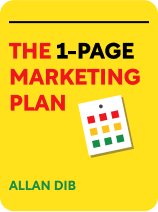

This article is an excerpt from the Shortform book guide to "The 1-Page Marketing Plan" by Allan Dib. Shortform has the world's best summaries and analyses of books you should be reading.
Like this article? Sign up for a free trial here .
What are the best marketing strategies for small businesses? How can you incorporate these strategies into your business’s marketing plan?
Entrepreneur and consultant Allan Dib argues that marketing is the highest-value activity a small business owner can engage in. In his book The 1-Page Marketing Plan, he outlines the best marketing strategies for small businesses and gives advice on how to implement them.
Find his six best marketing strategies for small businesses below.
The Best Marketing Strategies for Small Businesses
Expert marketer Allan Dib contends that for a small business, the surest way to make money and grow is to have a simple, clear marketing plan defining who you’re targeting as prospects and customers and how you’ll reach them.
In The 1-Page Marketing Plan, he shows step-by-step how to create a marketing plan using a simple template that will drive business growth. He also reveals his best marketing strategies for small businesses, including the best marketing mediums and why having a clear marketing plan is so important.
Dib says that most small businesses either 1) neglect marketing entirely, hoping simply to attract customers by word of mouth, or 2) they do the wrong kind of marketing, using big-business strategies that don’t work for small businesses.
Dib argues that the answer to small business success is having the right marketing plan, one focused on direct-response advertising designed to prompt the prospect to act. This is where his list of the best marketing strategies for small businesses can help.
(Shortform note: Similarly, a Forbes article lists not having a marketing plan as among the 10 most common small business marketing mistakes. Others include not having a website, prioritizing social media marketing over developing your website, failing to customize your marketing strategy, and ignoring competitors’ marketing strategies.)
1) Create a Clear Marketing Plan
The first of Dib’s best marketing strategies for small businesses is to have an overarching marketing plan.
Dib cautions that small business owners often become enamored with the latest digital marketing tactics—such as SEO, video, or pay-per-click advertising—before they’ve come up with an overall strategy. They cobble together a collection of random tactics in hopes of attracting customers, then wonder why they’re not getting results. (Shortform note: As one marketing strategist put it, that’s like going on vacation without picking a destination—you’re driving blind.)
In The 1-Page Marketing Plan, business coach and entrepreneur Allan Dib tells small business owners how to create a marketing plan using a simple template that guides you through three customer-focused phases of marketing: awareness, familiarity, and enthusiasm.
You can find a comprehensive guide to creating a full marketing strategy in our comprehensive summary of The 1-Page Marketing Plan.
2) Avoid Mass Marketing
Small business owners often try to emulate big business by using “mass marketing” to increase general awareness of their product or to create a positive image. However, Dib contends that this type of marketing wastes money because small businesses need to reach a targeted group of likely customers rather than a universe of people, the vast majority of whom won’t buy.
He believes the most effective marketing strategy for a small business owner is direct-response marketing.
Direct-response marketing is targeted to prospects most likely to be interested in your product or service; ads focus on solving their specific problem, and they’re designed to prompt an immediate response by encouraging people to take a specific action. For example, a financial planner might aim to get parents of high school-age children to sign up for a college finance webinar. Other “calls to action” include visiting a web page, signing up for a free report or newsletter, joining an email list, or buying.
Many small businesses try a mass marketing or branding approach of broadcasting their name widely and frequently in hopes that a small percentage of those who hear it will become customers. However, this type of marketing is costly and results are hit or miss. Dib recommends focusing narrowly on a single niche or subset of your market at a time.
(Shortform note: Similarly, in The 21 Immutable Laws of Marketing, the authors note that many businesses mistakenly believe that appealing to a wider audience will expand their customer base. However, the way to expand your customer base is actually to identify and focus on your strongest niche, because success in a niche expands the niche and beyond. For example, in advertising cigarettes, Marlboro targeted only men while other companies sought to attract both men and women. With its memorable campaign featuring cowboys, Marlboro led sales nationally among both men and women.)
3) Choose the Right Medium
To choose a medium or channel (such as direct mail/print, TV/radio, email, social media, or web/SEO), identify and go where your target prospects spend their time.
For affordability and effectiveness, Dib’s recommended media for small business marketing are email and direct (snail) mail.
Email Marketing
Email is an inexpensive, direct, personal way to reach prospects and customers, which also can be automated. Dib notes that with email, you can:
- Capture the email addresses of website visitors with an email opt-in form; those not ready to buy but interested in more information are future customers you can nurture.
- Develop relationships with your customers (so your email database grows in value).
- Test and launch new products and services.
- Generate instant cash—create a compelling offer with a response mechanism, send an email to your list, and you’ll get an immediate response.
Dib recommends using a commercial email marketing system such as MailChimp, ConvertKit, or ActiveCampaign (rather than trying to send mass emails via Outlook or Google mail). They meet compliance standards and work to improve delivery. Also, they automate sending.
Despite the allure of social media and email, Dib recommends that regular or snail mail also be a part of your marketing strategy. Direct mail works as a marketing medium because:
- People connect emotionally with physical things. Unlike emails, people save USPS letters and cards.
- Direct mail has a longer shelf life and takes more effort to dispose of than email—which can immediately be deleted and forgotten.
- Postal mailboxes are becoming less cluttered (allowing your message to stand out), while email inboxes overflow despite many sorting methods.
4) Be an Educator, Advisor, and Problem-Solver
You might offer something such as a free report or webinar, that educates your customers about a problem they have. Dib notes that continuing contact, while delaying a sale, further strengthens your position as an expert and advisor acting in the customer’s best interests to help you solve her problem. (Shortform note: The Challenger Sale approach positions salespeople not only as experts but also as teachers, challenging their thinking about their market and providing customers with new insights into their problems.)
5) Eliminate the Risk
Every buying decision carries a risk or fear of loss from choosing something that doesn’t pan out. Offering an extraordinary guarantee eliminates the risk. Dib says this guarantee should go beyond a simple refund to something specific and truly attention-grabbing—you’ll deliver the promised results or else. Determine the customer’s fear—for instance, that you’ll leave their house a mess while performing repairs—and promise that you’ll not only fix the problem forever, but also leave the house cleaner than when you arrived, or you’ll pay for a cleaner. Another way of eliminating risk is to allow the customer to try before she buys.
(Shortform note: In Traction, Gino Wickman recommends making a guarantee part of your marketing strategy. To come up with one, start by identifying your customers’ biggest frustrations and concerns, then develop a guarantee that will bring you more business by addressing those concerns. He also suggests calling your guarantee a pledge, commitment, or promise to give it added weight.)
6) Charge a Premium Price
The last of Dib’s best marketing strategies for small businesses is to charge a premium price.
Most businesses set prices based on their competition, or they calculate their cost and add a markup. This positions your product as a commodity, forcing you to compete on price, which is a downward spiral. Instead, Dib argues you should position yourself above competitors by charging a premium. This facilitates buying in several ways: A few customers will pay for the best, boosting your bottom line and attracting more high-end customers; and a high price for your main item will make other items seem reasonably priced.
(Shortform note: In New Sales. Simplified., Mike Weinberg cautions that if you charge a premium, you need to differentiate yourself to justify it—that is, you must sell the customer on the value you create for the price. The way to do this is to create a compelling sales story.)

———End of Preview———
Like what you just read? Read the rest of the world's best book summary and analysis of Allan Dib's "The 1-Page Marketing Plan" at Shortform .
Here's what you'll find in our full The 1-Page Marketing Plan summary :
- How to create a marketing plan using a simple template
- A guide to the three customer-focused phases of marketing
- How to create enthusiastic superfans—and why they're essential







Thanks for sharing this useful information! Hope that you will continue with the kind of stuff you are doing.